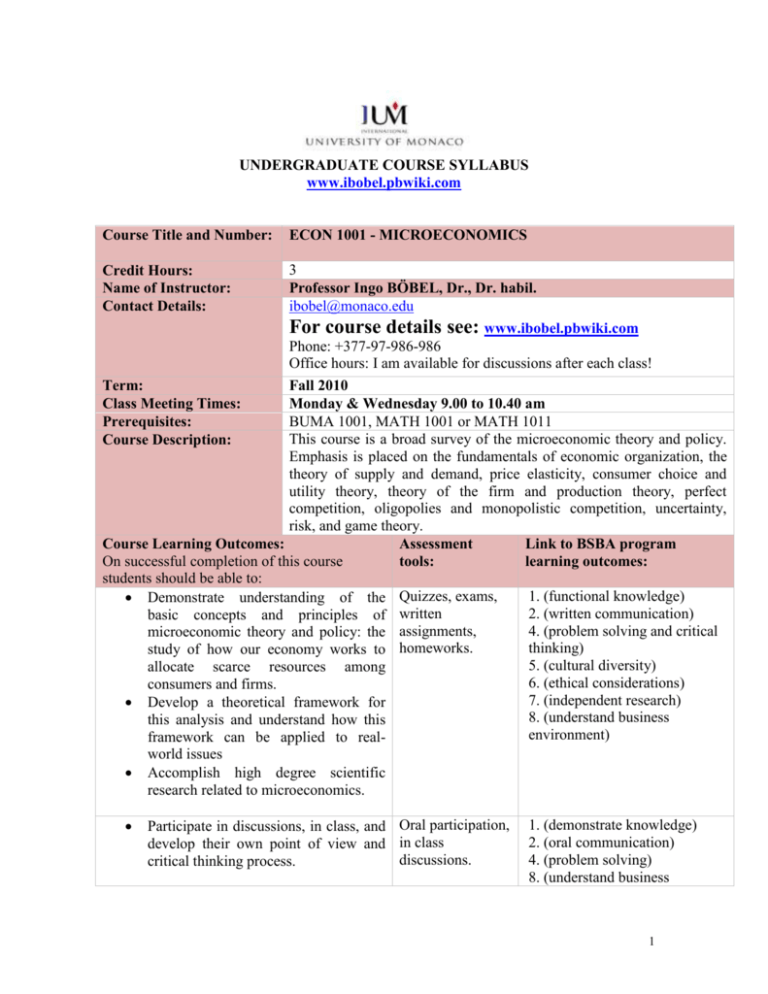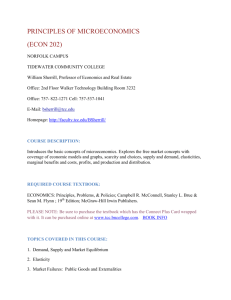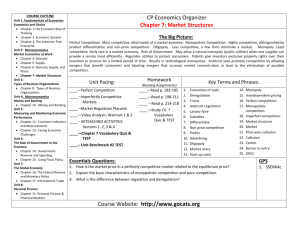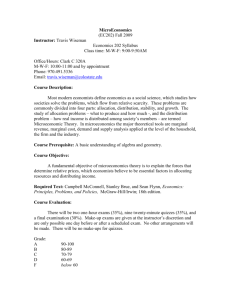Basic Elements of Demand Analysis
advertisement

UNDERGRADUATE COURSE SYLLABUS www.ibobel.pbwiki.com Course Title and Number: ECON 1001 - MICROECONOMICS 3 Professor Ingo BÖBEL, Dr., Dr. habil. ibobel@monaco.edu For course details see: www.ibobel.pbwiki.com Phone: +377-97-986-986 Office hours: I am available for discussions after each class! Term: Fall 2010 Class Meeting Times: Monday & Wednesday 9.00 to 10.40 am BUMA 1001, MATH 1001 or MATH 1011 Prerequisites: This course is a broad survey of the microeconomic theory and policy. Course Description: Emphasis is placed on the fundamentals of economic organization, the theory of supply and demand, price elasticity, consumer choice and utility theory, theory of the firm and production theory, perfect competition, oligopolies and monopolistic competition, uncertainty, risk, and game theory. Course Learning Outcomes: Assessment Link to BSBA program On successful completion of this course tools: learning outcomes: students should be able to: 1. (functional knowledge) Demonstrate understanding of the Quizzes, exams, 2. (written communication) basic concepts and principles of written 4. (problem solving and critical microeconomic theory and policy: the assignments, thinking) study of how our economy works to homeworks. 5. (cultural diversity) allocate scarce resources among 6. (ethical considerations) consumers and firms. 7. (independent research) Develop a theoretical framework for 8. (understand business this analysis and understand how this environment) framework can be applied to realworld issues Accomplish high degree scientific research related to microeconomics. Credit Hours: Name of Instructor: Contact Details: Participate in discussions, in class, and Oral participation, develop their own point of view and in class discussions. critical thinking process. 1. (demonstrate knowledge) 2. (oral communication) 4. (problem solving) 8. (understand business 1 Methodology: environment) The course will be taught in an interactive and participatory mode by interjecting lectures, discussions, exercises and case analysis throughout the course. Students must come prepared to each class by having read the chapters related to the course in the textbook and by having prepared the exercises indicated in the present syllabus, before class. Homework is assigned with the intent that students make an effort to understand the topic covered in the text prior to our in-class discussion so that we can move forward in class. All written homework must be typed, double-spaced and using Excel for spreadsheet work and problems. You may work together on the problems, but the answers must be written up in your own words. Use graphs whenever appropriate. I expect that students will actively use the library and the library resources that are available when solving homework problems or any other assignments. Required Textbook: Michael Parkin, Economics, 9th. ed., Pearson: Boston 2010 There is such a big choice of useful Microeconomic textbooks. I Other Resources/Recommended recommend the following modern texts as reference books: Readings: Paul A. Samuelson and William D. Nordhaus, Economics, 18th ed., Irwin/McGraw-Hill, 2007 Hal R. Varian, Intermediate Microeconomics-A Modern Approach, 7th ed., WW. Norton, 2006 R. Pindyck and L. Rubinfeld, Microeconomics, 3rd. ed., Prentice-Hall, 2004 Attendance: You will find that your understanding of both current economic events and economic analysis will be bolstered by the regular persual of periodicals such as The Economist, The Financial Times, The Wall Street Journal, and Business Week. (See the information given in the Preface Chapter in Parkin's book!) Students are expected to attend all classes! Absences affect the final course grade. See IUM Student Handbook for details. 2 Assessment Grading: and The final course grade will be composed of the following components with given weights: Class participation Homework Quizzes Final exam Academic Honesty: Class Code of Conduct 10% 20% 35% 35% Academic honesty is fundamental to the integrity of an educational community and the University views any incident of academic cheating or plagiarism to be very serious. A student who willingly gives or receives aid in examinations, copies another student’s work, or turns in any material claimed as his or her own, but coming from another source, is subject to an academic sanction. Any form of dishonest academic behavior has to be reported to the Academic Committee that will determine the sanction. 1. Students and the instructor must respect and preserve the integrity of the learning environment of the classroom. Accordingly, disruptive behavior is not permitted and will be reported to the Associate Dean for appropriate disciplinary action. Examples of disruption are the sound or any use of mobile telephones, entering or leaving the room during a class. 2. No eating, drinking, or smoking is permitted. 3. No caps or hats should be worn in class. 3 COURSE OUTLINE ECON 1001 MICROECONOMICS www.ibobel.pbwiki.com Session Topics covered 1 13.9.10 Course organization Introduction to Economics: The coordination of production, consumption and investment (scarcity and the basic economic questions: what, how, for whom, and who makes the decisions); the Economic Way of Thinking (how to make choices). The Economic Problem: Budget constraint, Ch 2/ time constraint, PPF: Production Read pp. 32-39, 43-56 Possibilities and Opportunity Cost (the meaning of trade offs and opportunity costs), the marginal principle (marginal cost); sunk costs. The circular flow model The Market Economy: markets, prices, and the role of government in a modern economy; the role of prices in a market economy (the functions of prices). Quiz 1 Ch. 2/pp. 40ff. 2 3 Sep. 20 Readings/ Assignments Relevant chapter numbers correspond to the required textbook by M. Parkin Ch 1 including the Appendix Gains from Trade (absolute and comparative advantage) 4 Gains from Trade (absolute and comparative advantage) cont’d. Ch. 3/ The Demand and Supply Framework: Basic Elements of Demand Analysis The basic competitive model; the demand function; determinants of demand; the law of demand; normal vs. inferior goods; substitutes vs. complements; the ceteris paribus assumption; demand schedule vs. demand curve; individual demand vs. market demand; shifts of the demand curve vs. movement along a demand curve; the case of reducing the demand for smoking as an 4 example. 5 Sep. 27 Quiz 2 Basic Elements of Supply Analysis: determinants of supply; the law of supply; the supply schedule vs. the supply curve; individual supply vs. market supply curves; shifts in supply; movement along a supply curve vs. shifts in supply. Market Equilibrium: Supply and Demand together: The equilibrium on a market; comparative statics: comparison of equilibria; the cases of surplus and shortage (deviations from the market equilibrium); price floors and price ceilings Ch. 3 / 6 Extensions of Supply and Demand Analysis The Price Elasticity of Demand: theoretical considerations; the determinants of the price elasticity of demand (necessities vs. luxuries; characteristics of markets; time horizon; etc.); five cases of changes in elasticities (incl. the extreme cases of perfect elasticity and a perfectly elastic demand); calculations of elasticities (examples using the mid-point method); numerical examples calculating elasticity; price elasticity of demand vs. the slope of the demand curve. Practice session: Solving problems on Elasticities Ch. 4 7 Oct. 4 Quiz 3 Practice session: Solving problems on Elasticities Ch. 4 8 Organizing Production: Theory of the Firm The firm's goal; measuring a firms profit; accounting profits vs. economic profits. Markets and market structures: The competitive landscape; measures of concentration; the structure-conductperformance paradigm Quiz 4 Production Theory Production with one variable input Ch.10/ 9 Oct. 11 Ch. 11/pp. 252ff. 5 10 11 Oct. 18 (will be reschedul ed) 12 Oct. 20 (will be reschedul ed) 13 14 15 16 17 Output and Costs Short-run costs: Total cost; fixed cost; variable cost; marginal cost; average cost; how do cost curves run?; the relationships between the different cost curves. Long-run costs: the production function; long-run average cost curve Quiz 5 Output, Price and Profit in Perfect Competition Short-run equilibrium; change in demand; long-run adjustments; entry and exit decisions: shut down vs. exit decision; changes in plant size; Changes in tastes and technology Market Imperfections Monopoly (The problem of market power; how monopoly arises; price-setting strategies; output and price decision in a monopoly: price and marginal revenue; marginal revenue and elasticity; output and price decision). Quiz 6 Monopoly vs. perfect Competition: A Comparison Price discrimination Review Session Monopoly Policy Issues Gains from monopoly; natural monopoly; regulating natural monopolies; marginal cost pricing and average cost pricing rules. Quiz 7 Monopolistic Competition (I) Definition of market structure; product differentiation; competing on quality and price; entry and exit; output and price under monopolistic competition; economic profits in the short-run and in the long-run Monopolistic Competition (II) Monopolistic Competition and Perfect Competition Product Development and Marketing Oligopoly Barriers to Entry Game theoretical considerations; what is a game?; the prisoner's dilemma; price fixing Ch. 11 pp. 257ff. Ch. 12 Read on p<AVC: http://news.yahoo.com/s/ap/20091 127/ap_on_bi_ge/us_farm_scene_ unpicked_apples Ch. 13 Read all relevant chapters in Parkin and your class notes incl. homework questions Ch. 13 Ch. 14 Ch. 14 Solve short answer questions (given in class) and self-test questions Ch. 15 6 18 19 game in an oligopoly; collusion; Nash equilibrium and Duopoly; Repeated games and sequential games Regulation and Antitrust Law (I) Market intervention; regulation; antitrust law; economic theory of regulation Regulation and deregulation; natural monopoly again; rate-of-return regulation Quiz 8 Regulation and Antitrust Law (II) Antitrust Law Understanding Market Failure and Government 20/21 Review Sessions Preparation for Final Exam 6.12.10.12. FINAL EXAM WEEK Ch. 15 Solve short answer questions (given in class) and self-test questions Ch. 15 Read all relevant chapters in Parkin and your class notes incl. homework questions Please note that the professor reserves the right to modify this outline. Make-upclass dates will be announced – the topic schedule will change accordingly! Last updated: July 6, 2010 7







